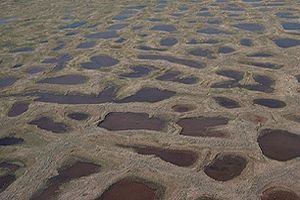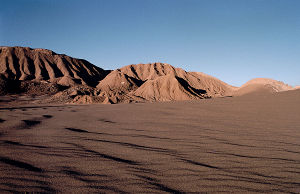Extremophiles: Difference between revisions
| Line 14: | Line 14: | ||
[[File:ValleLuna-002.jpg|thumb|The Atacama desert, subject of intensive research due to the diverse extremophilic organisms found residing there.]] | [[File:ValleLuna-002.jpg|thumb|The Atacama desert, subject of intensive research due to the diverse extremophilic organisms found residing there.]] | ||
[[File:Aspergillus sp. 4.5X (1).JPG|left|250px|Aspergillus sp, an extremophilic fungi that contains the species that causes black mold. They are able to survive where high osmotic pressures exist.|thumb]] | [[File:Aspergillus sp. 4.5X (1).JPG|left|250px|Aspergillus sp, an extremophilic fungi that contains the species that causes black mold. They are able to survive where high osmotic pressures exist.|thumb]] | ||
Bioremediation refers to the use of an organism in degradation of contaminants that pose environmental and human risks. There has been a number of extremophilic organisms successful in remediation of contaminated | Bioremediation refers to the use of an organism in degradation of contaminants that pose environmental and human risks. There has been a number of extremophilic organisms successful in remediation of contaminated soil [3]. | ||
In a process known as bioleaching, acidophiles have been successfully utilized in | |||
Deinococcus radiodurans is a radiation-resistant bacteria occurring naturally in the cracks of rocks in Antarctica that has been genetically engineered by inserting a gene the mercuric reductase gene from Escherichia coli to be useful in remediation of heavy metals and radiation in nuclear waste sites. The gene combined with the bacteria's ability to tolerate radiation has made it a reliable option degrade mercury in radiation enriched soil environments [6]. | |||
In a process known as bioleaching, acidophiles have been successfully utilized in minimizing the number of pollutants from on mine sites. The fungi ''Aspergillus sp'', which also causes black mold, and the bacteria ''A.ferrooxidans'', have been used to remove nickel from contaminated soil and wastewater [7]. This same process has also been used for extraction of nickel and other metals, as discussed in [[Biotechnology]]. ''Acidithiobacillus sp'' has been successful in removing sulfur from coal in order to help prevent acid rain [8]. The soil of the Atacama desert, noted for its similarity to mars, is now being heavily studied due to the vast variety of extremophilic organisms found there with high bioremediation potential [9]. | |||
==Biotechnology== | ==Biotechnology== | ||
Revision as of 20:37, 7 May 2019
An Extremophile is an organism that experiences optimal growth in environments outside the realm of what is considered “normal” and may even require intense geochemical or physical conditions to survive [1]. Extremophiles associated with plants encompass all three domains of life: Archaea, Bacteria, and Eukarya. Within these domains, they can be found in different phylums and groups such as Actinobacteria, Ascomycota, Bacteroidetes, Basidiomycota, Crenarchaeota, Euryarchaeota, Firmicutes and Proteobacteria. Extremophilic microbes that benefit plant health and soil fertility are Arbuscular Mycorrhizal Fungi and bacteria found in the rhizosphere growing under abiotic stress conditions of temperature, salinity, pH and water deficiency. These microbes are said to be psychrophiles (-2°C to 20°C), thermophiles (60°C to 115°C), halophiles (2-5M), acidophiles (pH<4), alkaliphiles (pH>9) and xerophiles (water potential 0.75 kPa) [2]. Though not intensively studied until recently, extremophiles may have huge potential in the application of agriculture, biotechnology and bioremediation [3].
Agriculture
Extremophilic microbes found in soils and within plants present a of variety of benefits towards increasing overall plant health. They have ability to produce phytohormones, solubilize nutrients, and attack pathogens.
There has been success in applying these microbes as biofertilizers for crop improvement and soil health as a sustainable option[2]. Two rhizobacteria root endophytes that are found in Antarctica, Penicillium chrysogenum and Penicillium brevicompactum, increased fitness in cayenne, lettuce, onion, and tomato in high salinity environments by limiting the intake of salt. This has useful application in reduction of saline stress on plants that are not saline tolerant, such as lettuce [4].
In another study, endophytic mycorrhizae isolated from the roots of a tomato grown in intense drought and saline conditions was found to activate and stimulate defense mechanisms within plants to achieve improved growth [5]. There is an extreme interest in extremophilic microbes found in cold environments due to their ability to thrive in what is often a high salinity and arid environment, but full potential of these microbes in agriculture is still being discovered and researched, for example the recent increase in the reports of acidophiles found in plants growing within acidic soil [2].
Bioremediation
Bioremediation refers to the use of an organism in degradation of contaminants that pose environmental and human risks. There has been a number of extremophilic organisms successful in remediation of contaminated soil [3].
Deinococcus radiodurans is a radiation-resistant bacteria occurring naturally in the cracks of rocks in Antarctica that has been genetically engineered by inserting a gene the mercuric reductase gene from Escherichia coli to be useful in remediation of heavy metals and radiation in nuclear waste sites. The gene combined with the bacteria's ability to tolerate radiation has made it a reliable option degrade mercury in radiation enriched soil environments [6].
In a process known as bioleaching, acidophiles have been successfully utilized in minimizing the number of pollutants from on mine sites. The fungi Aspergillus sp, which also causes black mold, and the bacteria A.ferrooxidans, have been used to remove nickel from contaminated soil and wastewater [7]. This same process has also been used for extraction of nickel and other metals, as discussed in Biotechnology. Acidithiobacillus sp has been successful in removing sulfur from coal in order to help prevent acid rain [8]. The soil of the Atacama desert, noted for its similarity to mars, is now being heavily studied due to the vast variety of extremophilic organisms found there with high bioremediation potential [9].
Biotechnology
Extremophilic organisms have been increasingly researched as an option for a cleaner fuel source. Cyanidium caldarium and galdieria sulphuraria contain long chain hydrocarbons similar to those found in petroleum. They can be found in bogs and moist acidic soil all over the world and grown in open containers as the high salinity required for growth inhibits most other microbes [10]. Extremophilic microbes have also show great promise in medical applications. Antimicrobial peptides have been found in halophiles belonging to numerous species that reside in soils. Peptides from halophiles are referred to as halocins, which have been shown to be effective at killing archaeal cells [11]. There has also been numerous research done showing the ability to assist canines in recovery from surgery [12]. Diketopiperazines, also found in halophiles, have shown to ability to reduce tumors and reduce blood clotting. An example of this is Naloterrigena hispanica, found in the soils of an extremely salty lake in Fuente de Piedra, Spain.
An extremely intriguing contribution from extremophiles may come from an alternative method for vaccines. Halobacterium, another organism found in extremely salty environments, produce internal gas vesicles and small gas-filled proteinaceous structures [13]. These structures have been engineered to show a recombinant form of an immunodeficiency virus on the external surface of the bacterium. These newly formed vesicles have shown a strong antibody response and long lasting immune memory when administered nasally to mice. The vaccine showed no toxicity in mice and is being further studied [13].
Refrences
[1] Rampelotto P. H. (2013). Extremophiles and extreme environments. Life (Basel, Switzerland), 3(3), 482–485. doi:10.3390/life3030482
[2] Yadav, Ajar Nath. (2017). Beneficial role of extremophilic microbes for plant health and soil fertility. Journal of Agricultural Science and Botany. 1. 1-4.
[3] Kristjánsson, J.K. & Hreggvidsson. (2017). G.O. World Journal of Microbiology & Biotechnology 11: 17. https://doi.org/10.1007/BF00339134
[4 ]Acuña-Rodríguez Ian S., Hansen Hermann, Gallardo-Cerda Jorge, Atala Cristian, Molina-Montenegro Marco A. (2019). Antarctic Extremophiles: Biotechnological Alternative to Crop Productivity in Saline Soils. Frontiers in Bioengineering and Biotechnology. 22.
[5] Khan, A.L., Waqas, M., Khan, A.R. et al. World J Microbiol Biotechnol (2013) 29: 2133. https://doi.org/10.1007/s11274-013-1378-1
[6] Rew, D. A (1 August 2003). "Deinococcus radiodurans". European Journal of Surgical Oncology (EJSO). 29 (6): 557–558. doi:10.1016/S0748-7983(03)00080-5
[7] Mohapatra, S.; Bohidar, S.; Pradhan, N.; Kar, R.N.; Sukla, L.B. (2007). "Microbial extraction of nickel from Sukinda chromite overburden by Acidithiobacillus ferrooxidans and Aspergillus strains".
[8] Rai, Charanjit; Reyniers, Jon P. (1988). "Microbial Desulfurization of Coals by Organisms of the Genus Pseudomonas". Biotechnology Progress. 4 (4): 225–30. doi:10.1002/btpr.5420040406.
[9] Orellana, R., Macaya, C., Bravo, G., Dorochesi, F., Cumsille, A., Valencia, R., … Seeger, M. (2018). Living at the Frontiers of Life: Extremophiles in Chile and Their Potential for Bioremediation. Frontiers in microbiology, 9, 2309. doi:10.3389/fmicb.2018.02309.
[10] Pulz O, Gross W.(2004).Valuable products from biotechnology of microalgae. Applied Microbiol Biotechnology;65(6):635–48. 10.1007/s00253-004-1647-x
[11] DasSarma P, Coker JA, Huse V, et al. : Halophiles, Industrial Applications. In: Encyclopedia of Industrial Biotechnology Hoboken, NJ, USA: John Wiley & Sons, Inc.2009.
[12] Shand RF, Leyva K: Archaeal antimicrobials: an undiscovered country. In: Paul Blum ed. Archaea: new models for prokaryotic biology Norfolk, UK: Caister Academic Press,2008;233–44.
[13] Stuart ES, Morshed F, Sremac M, et al. : Antigen presentation using novel particulate organelles from halophilic archaea. J Biotechnol. 2001;88(2):119–28. 10.1016/S0168-1656(01)00267-X




